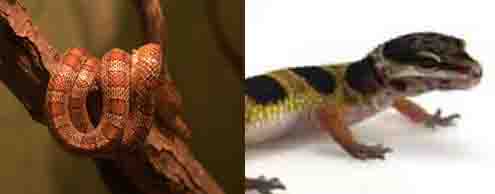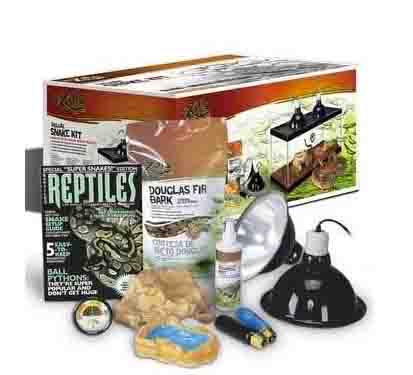How to Choose Pet Reptiles
There are many types of pet reptiles to choose from. You may hear
that people who care for reptiles and amphibians are known as
herpetologists or herps. If you are just starting out, then choose one
of the reptiles listed below that are easy to care for. Other
reptiles are best left to intermediate caretakers. All of the
recommended reptiles listed below do well in captivity.
Reptile is a term that applies to many types
of animals including:
- Turtles, tortoises and Terrapins (Testudines, 300 species)
- Further divided by marine, semi aquatic and terrestrial
(tortoises are terrestrial)
- Lizards, Snakes (Squamata, 9150 species)
- From many types of environments, semi-aquatic to desert)
- Tuataras (Sphenodontia, 2 species, distinct from New Zealand)
- Crocodiles, Gavals, Caimans, Alligators (Crocodilia, 23 species)

Two of best pet reptiles are Corn
Snakes and Geckos
Choosing the Perfect Pet Reptile or Amphibian
Reptiles that are Wild or Bred in Captivity:
Pet reptiles are either caught in the wild or purchased from a breeder. Both types are found in pet stores. In general, it is better to raise a reptile born into captivity. These tend to be less stressed and used to being caged. It is also easier to breed a reptile that was born in captivity. They are also likely to be healthier with a lower incidence of parasites. Capturing a wild reptile can be illegal depending on where you live and the species. Taking any animal out of the wild is subject to debate since it disturbs the local ecosystem.
Reptile Stores
Reptiles can be purchased from several types of places. Be sure to check the reputation of anyone selling reptiles. These include:
- Reptile or Herb Expos: These events or reptile shows feature breeders for many types of species. There are several reptile hobby magazines that list shows in your area such as Reptile Magazine. Online resources for finding reptile shows include:
- Reptile Dealers: There are distributors that specialize in supplying stores and individuals with reptiles. There are also classifieds in the magazine listed above.
- Pet Stores
Note that if you order reptiles online, that shipping can harm the animal. Avoid ordering reptiles in the peak of the summer heat or height of winter cold. There are also premium shipping services that will pick-up your order from the airport. Check with the reptile dealer regarding shipping methods and policy. For example, if the reptile arrives at your home in poor health or the reptile is dead, what is the policy. A reputable dealer will guarantee the quality of pets shipped.
Reptile Cage, Size and Environment
As mentioned above, reptiles come in many shapes and sizes. They also require different types of habitats depending on the needs of the animal. Considerations include:
- Temperature: Reptiles are ecotherms, which means that they
cannot regulate their own body temperature. Because of this they
rely on the outside environment having the various temperatures
needed. During the day this includes an area to bask or warm up
under a heat lamp, a slightly cooler daytime area, and then a night
time temperature for the entire environment.
- Reptile Cages: Environments are further complicated by required substrates (material on the bottom of the reptile cage), lighting requirements and size. Smaller reptiles such as Geckos require smaller cages, while others require much larger enclosures. The typical reptile cage includes:
- Aquarium or Terrarium with a secure screened top
- Heat pad or other ceramic heater
- Hide box for provide privacy inside the aquarum
- Water dish
- Substrate to cover the bottom of the terrarium
- Furniture that mimics the reptile pets natural environment

Snake or Care of most Reptile Pets can be simplified for beginners with an all-in-one Reptile or Snake Kit
Shown: 20 Gallon Snake Kit from Amazon
- Reptile Terrarium: Each terrarium mimics the reptiles natural environment. This means that furnitures(hiding places, rocks) needs to provide the right type of climbing, hiding and basking areas. Each reptile also has an ideal humidity level (high humidity for topics, low for desert). For lizard pictures and care descriptions. see the following resources:
- Reptile Diet or Food: Reptiles vary based on their choice of
diet. Most reptiles bred in captivity will eat a combination of
foods. There are also commercial diets available for more popular
species.
Dietary reptile food groups include: - Herbivores: Plant eaters, such as dark leafy greens
- Insectivores: Insect eaters, such as crickets, worms
- Carnivores: Meat eaters, small pink mice
- Omnivores: Meat and Plant eaters.
- Pet Reptile Condition: Be sure to look over any reptile before purchase. Look for signs of health problems such as:
- Injuries
- Diet or malnourished
- Signs of Shedding which did not fall off the body
- Eyes which are clear and not cloudy
- Signs of swelling
- Twitching against side of reptile cage: sign of mites
There are also signs of reptile health that are specific to certain reptile species:
- Snakes: Skin should be completely shed around the eyes to
avoid infections. Inspect belly for burns which come from
exposure to hot rocks in a reptile terrarium.
- Amphibians and Lizards: Avoid the animal is you see any red spots on the body. This is a sign of undernourishment
Pet Reptiles and Veterinary Care
It is acceptable to have your veterinarian examine any pet, including
reptiles, prior to purchase. You can also pay for a purchase, but
make it contingent on a veterinary examination. Common reptile
diseases
include:- Parasites (ticks, mites)
- Injuries (bites, burns from heat lamps, limb loss or tail broken off)
- Broken teeth or jaw (mouth rot)
- Respiratory Problems
- Bacterial, viral and Fungal disease
- Nutritional Disorders
Most Popular Pet Reptiles
As mentioned, your choice of a pet reptile changes if you are a beginner, intermediate or advanced herp. This list from PetSmart represents different reptiles classified by the difficulty of care. Click on the links to learn more about each type of pet reptile.- Pet Reptiles for Beginners:
- Anole
- Aquatic Turtles
- Bearded Dragon
- Chubby and Tomato Frogs
- Curly-Tailed Lizard
- Eyelash Crested, Gargoyle, Panther Geckos and Leopard Geckos
- King, Milk and Corn Snakes
- Skinks
- Stepp Runner
- Tree Frogs
- Pet Reptiles for Intermediate Herps
- Ball
Python Snake
- Chinese Water Dragon and Frilled Dragon Lizards
- Crocodile, White-Line and Golden Gecko
- Frilled Dragon
- Mail Uromastyx
- Pixie Frog
- Red Foot, Russian and Greek Tortoise
- Pet Reptiles for Advanced Herps:
- Chameleons
Pet Reptiles to Avoid
The following represents reptiles that you might want to avoid since they do not do well in captivity.- These snakes are too large, and dangerous to handle:
- Reticulated Pythons: Growth to 25 feet,
- Burmese Pythons: Also large, at 20 ft. This snake is a constrictor.
- Common Boa Constrictor: Grows up to 20 ft, Constrictor,
- Amazon Tree Boa: 6 ft. long
- Turtles and Tortoises
- Red-eared Slider: Turtle that is 8+ inches long. Not recommended due to salmonella risk in turtles greater than 4 inches in length. Requires a large reptile terrarium that includes a swimming area and area for basking in the heat.
- African Spurred Tortoise: Adults grow to 60 to 120 pounds.
- Lizards
- Horned Lizards: Harvester ants are part of the diet.
- Senegal Chameleons: Senegal chameleons are oten caught in the wild. They do not adapt well to captivity. The chameleon also is known to have an above average incidence of parasites.
- Green Iguana: Grow to 6 feet. Seasonal breeding results in male
Green Iguanas becoming difficult to handle, including biting and
scratching.
- Frogs:
- Suriname Horned Frog: Do not do well in captivity. May
not eat
Have a Reptile Question for our Vet? We Will Answer it for Free!
Do you need some reptile care or selection advice? Just ask a question and our Vet will answer it as soon as possible.
If your question is medical or behavior related, please include information such as species, age, diet, habitat and anything related to the medical history of your reptile.
Please upload a picture of your reptile, especially if you believe it will help the Veterinarian. Please know that we receive many questions and answer them on a first come, first served basis. If you need an immediate response, we suggest you use this online veterinary service that is available now to answer your questions.
References:
The 25 Best Reptile and Amphibian PetsR.D. Bartlett
Rosamond Gifford Zoo Education Volunteers
Willmet Pet Center, Wilmette, IL
Best West Pet Foods
Western New York Herpetological Society
Comments
Have your say about what you just read! Leave me a comment in the box below.